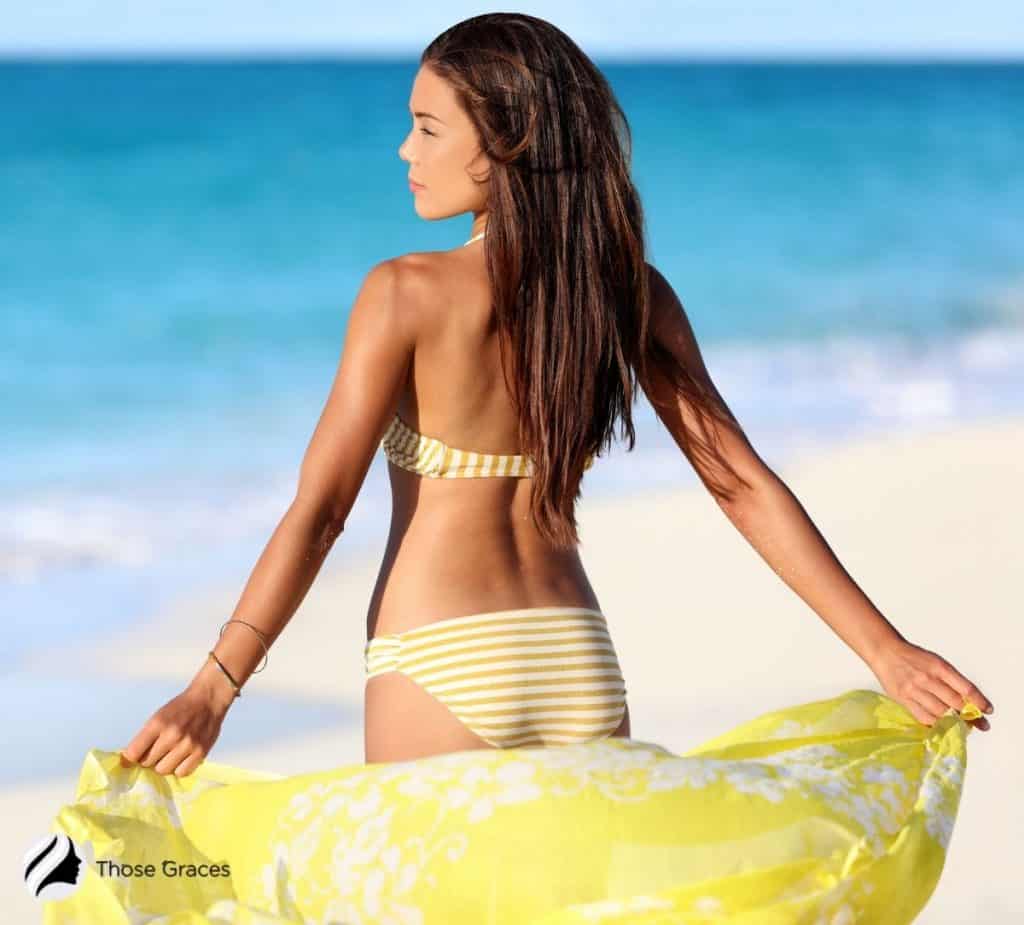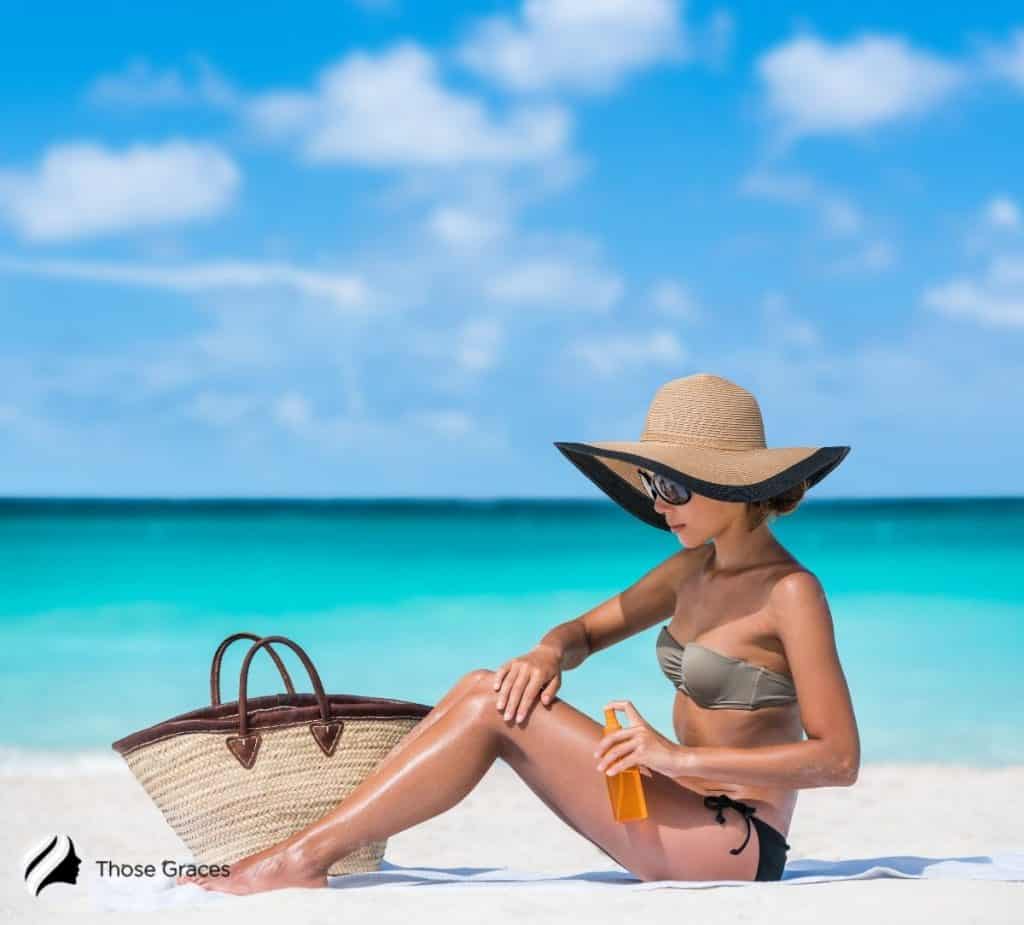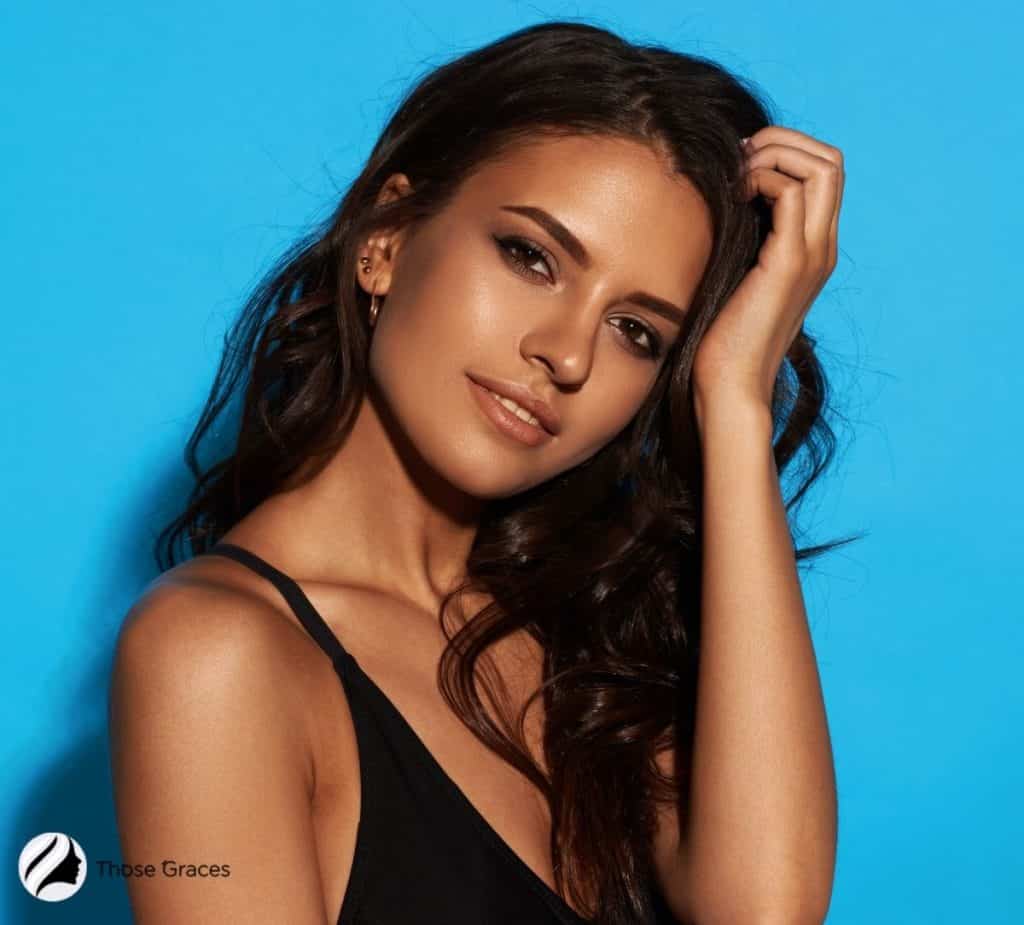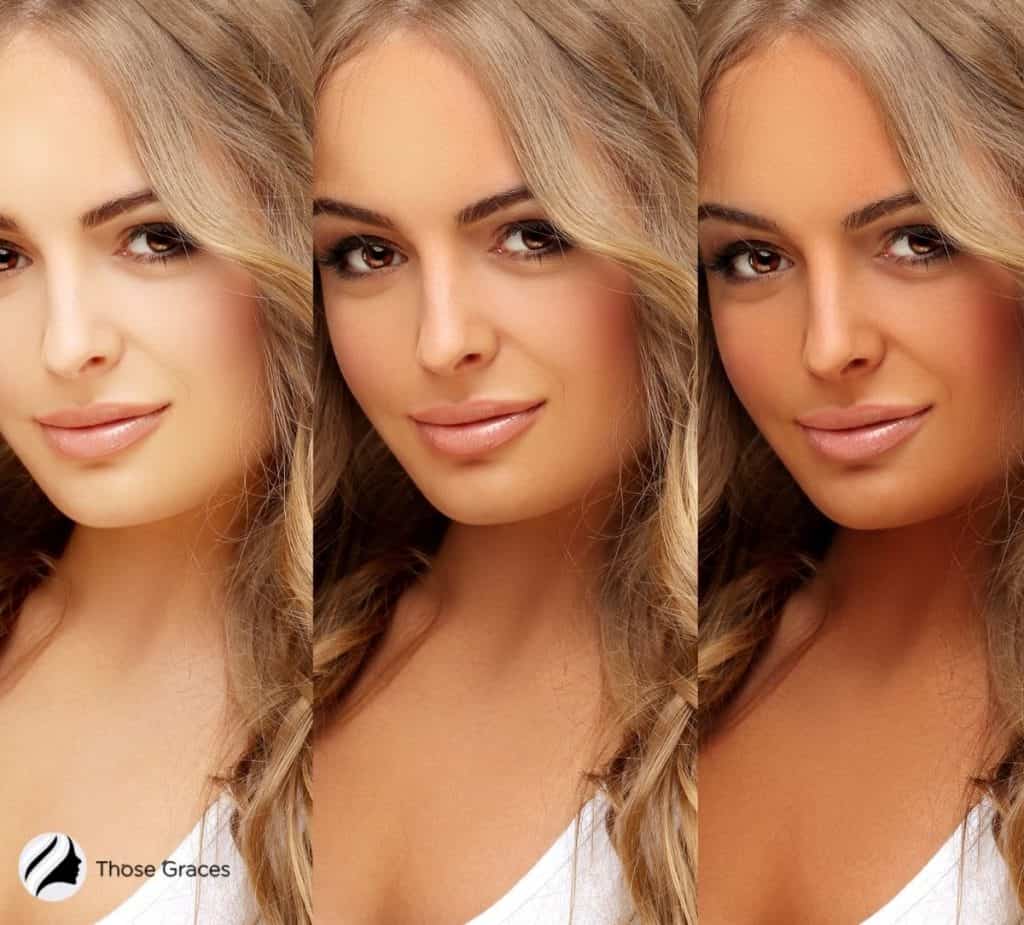Ever wondered why people tan? Or is tanned skin really more attractive?
We explore academic research to find out!
Keep reading to learn about the way tanning behavior is influenced by evolution.
We also discuss the experimental studies that test a preference for tanned or paler skin.
Plus, uncover how eating carrots can trick people into thinking you’re healthier (and therefore more attractive)!
Note: Due to a lack of adequate information available on other parts of the world, this post will mostly focus on Western countries.
Table of Contents
Why Do People Tan? Is it Really More Attractive?
One of the most common reasons people tan is the belief that they will look more attractive with a tan.

Tanning (or not tanning) is, of course, a personal preference. However, this decision is sometimes influenced by cultural factors (which are susceptible to evolving over time) and hard-wired evolutionary psychology.
Cultural Factors | Attitudes Towards Tanning In A Social Group Can Influence The Tanning Decision
Like many other physical features (body shape, hair color, etc.), there is a huge variation in preference for skin tone across the world.
Results from one study suggest many European populations favor tanned skin tones, while certain Asian population groups prefer lighter skin tones. Caribbean participants in this same study had a preference for darker skin tones. 1
These results point to a lack of universal cultural standards when it comes to skin tone attractiveness.
Swami et al. highlight that some results in the skin color preference literature suggest a form of ‘ethnocultural endogamy’ is at play (a preference for physical traits resembling members of your own group). 1
While other results appear to indicate a preference for wanting what you don’t have. 1
As we discuss further in our post on the history of tanning, preferences for skin tone within a cultural context are not fixed and are susceptible to change over time.
Tanned Skin Is Culturally Popular In America
Attitudes toward tanning among young adults in Chicago suggest modern American culture places value on tanned skin.
• In 1988, 58% percent of survey respondents said people looked better tanned. 2
• In 2007, a whopping 81% said people are more attractive with a tan. 2
A further study surveyed 10,000 girls and boys aged 12 – 18 on their attitudes towards tanning and tan skin in 1999. 3
The results revealed 75% preferred tanned skin, and 26% even said it was worth getting sunburned in order to achieve a tan. 3
Those who tan may feel culturally pressured to do so in order to blend in.
The Tanning Decision Has Real-Life Consequences In Certain Cultures
Some people may tan because they feel they will be treated better tanned than pale.
Evidence suggests tanned people are treated more favorably in certain contexts.
• Tan men and women are perceived to be friendlier, more popular, fitter, and healthier. 10
• One study revealed that, in an experimental setting, employers were more likely to rate a job candidate favorably if they had a tan than if they did not have a tan. 4
Check out this video entitled “Why White Folks Love Sun Tanning”:
Evolutionary Psychology Influences Our Tanning Behavior
Evolutionary psychologists attempt to uncover why a particular behavior evolved in the manner that it did.
Women Are More Knowledgable About The Dangers Of Tanning
Multiple studies reveal women, young people, and single people as the key tanning demographics.

Women, single people, and younger people tan more than men, married people, and older people do.5
Although knowledge about the dangers of skin cancer is ever increasing, more and more college students are choosing to tan. 11 Another study found women in college, (and college students who were currently dating) participated in greater levels of risky tanning in the sun than their male counterparts. 6
Women are more educated than men on the dangers of tanning. Despite their greater knowledge, they tan more than men.5
Given Their Knowledge, Why Do Young Single Women Tan More Than Men?
Academics propose an evolutionary psychology explanation for this risky behavior.
“That so many should engage in behavior [sun tanning] so seemingly self-destructive can only suggest that powerful motivating psychological forces are at work.”
Koblenzer, 1998, page 421 8
Some women report that their tanning habits are partially influenced by their desire to appear attractive in the eyes of men. They believe tanning makes them look healthier and more attractive. 7
Women are more educated on the risks of suntanning, but they also believe tanning will help them become more attractive.
Tanning Under The Darwinian Perspective Of Mate Selection
Saad and Peng (2006) theorize some women will take on the negative health risks of tanning because the positive result of looking more attractive to a potential mate is worth the risk. 5
The health risk is not worth it for men because they signal their attractiveness to potential mates in different ways. 5
This would support the Darwinian perspective of mate selection. 5
External Opinions On Attractiveness Influence Tanning Behavior
There’s some evidence that women feel pressure to adopt a tan (or be pale) based on others’ opinions of what looks more attractive.
• When the attractiveness of a tan was highlighted to the female participants in one particular study, they indicated a higher willingness to engage in tanning. 9
• When the attractiveness of paleness was emphasized instead, they displayed a lower willingness to tan. 9
• After reading an article about the attractiveness of pale skin, the participants reported a higher willingness to use sunscreen. 9
Is A Tan More Attractive?
As we learned above, survey data reveals people say tanned skin is more attractive, and they believe they themselves look better with a tan.
But those are just words.
Our revealed preferences are uncovered in real-life situations. Studies that make use of real-life situation experiments will help us understand whether or not a tan is really more attractive than paler skin.
Just like our perception of the way people look before and after makeup can significantly change, the way a person looks before and after a tan can also influence how attractive we find them.

Hotornot.com: Do People Find A Photo of A Person More Attractive With Or Without a Tan?
One image-heavy study investigated whether or not people really find tanned skin more attractive.
Photos of 45 female university students (aged 21 – 35) were uploaded to the website ‘hotornot.com’ both before and after a digitally added ‘tan’. The tan was edited using Adobe Photoshop. 12
Hotornot.com is a website where members of the public rate the attractiveness of a person (based solely on their physical appearance) on a scale of 1 – 10.
Each image stayed on the website until it received at least 100 votes. Initially, the study also included 5 male subjects. However, they were later excluded because their images on hotornot.com didn’t receive the threshold of 100 votes.
Women with skin darker than type V on the Fitzpatrick scale (a classification scale for skin color) were excluded. This is because the difference in their skin tone before and after the digital tan would not be significantly noticeable.
Hotter With A Tan Than Without One
• 30/45 of the photos on Hotornot.com had a higher rating with the added tan than without. Of these 30, 40% were rated significantly more attractive with the tan.
• 15/45 of the photos received a lower rating after the tan. Of these 15, only 13% were rated significantly less attractive with the tan.
The results suggest tanned skin is more attractive than paler skin.
However, limitations of this study include the small sample size, selection bias (hotornot.com users may not be representative of the general population), and the lack of male subjects. Plus, the tan generated in Photoshop may look inauthentic. 12
A Light, Medium, or Dark Tan: What’s More Attractive?
Another piece of research instructed both men and women to rate the appearance of a female model in digitally edited photographs. The model appeared with three different types of digitally edited tan: a light tan, a medium tan, and a dark tan. 7
• Men rated the model the most attractive when she had the darkest tan level. Women, on the other hand, did not have a significant preference for any tan level on the model.
• Men also rated the model at the darkest tan level as healthier and more interpersonally attractive than when she was at the medium tan level. (Though on this occasion, their preference level for the darkest tan did not differ much from the light tan level). Women did not show a significant preference for any tan level once again.
• Unlike the women, the men also perceived the model as thinner at the deeper tan level than the medium or light tan.7
This suggests men are particularly susceptible to finding a deep tan attractive and associating positive traits with a deep tan.
Bodybuilders Tan To Look Leaner and Define Their Muscles
A further study compared the tan levels of men and women in magazines. Interestingly, male models in muscle enthusiast fitness magazines were found to have the darkest tan levels, while women in mainstream fitness magazines had the lightest tan shades.
Male models in these types of magazines were 54% more likely to sport a darker tan than women. 18 This is likely because bodybuilders look leaner with a tan and the darker color outlines their muscles. 19

Yellow Is The New Glow: Do Yellow Undertones Drive Tan Attractiveness?
Researchers took photographs of 21 Caucasian men and 30 Caucasian women aged 18 – 22. None of the participants wore makeup in the photographs. All participants posed with the same neutral expression in a booth with lighting similar to sunlight. 13
20 Caucasian women and 12 Caucasian men (all aged 19 – 26) were recruited to digitally manipulate the coloration in the photographs (in a Photoshop-like tool).
22 others with a similar background participated by digitally performing 2D transformations on the photographs.
Participants were given clear instructions to make a face in each photograph look as healthy as possible by digitally adjusting the skin coloration.
Skin Tone As A Sexually Dimorphic Trait
Overall, the participants made the skin in the photographs red, lighter, and yellow.
Participants made women’s faces lighter than they made men’s faces. They also chose to redden and add yellow to men’s faces more than they did to women’s.
The authors suggest this highlights an existing sexual dimorphic trait: men in many different populations are browner, darker, and ruddier than women from the same ethnic group. 13
This Sexually Dimorphic Preference Is Supported By Hormone Research
In another study, 98 women were shown six pairs of photographs of both men’s and women’s faces. Within each pair, the faces were identical, with the exception of slight changes in completion. 16
Women who were not taking oral contraceptives preferred the darker male face during the phase at which the estrogen/progesterone ratio was highest in their cycle (compared to those who were at the low estrogen/progesterone ratio phase). 16
These women did not show this preference towards the pictures of females. Women taking oral contraceptives showed no menstrual cycle response to either set of faces. 16
(However, it’s important to note that a lot of social science research related to the impact of contraceptives on attraction has thus far failed to replicate).
Ancient Artwork With Exaggerated Skin Tone Difference Between Men and Women
Many ancient artworks (including Roman, Etruscan, Egyptian, and Greek) feature paler females and darker males.
The classic explanation for this phenomenon is that it reflects the indoor life of the woman and the tan-inducing outdoor life of men. 14
However, this difference in portrayal is possibly driven by ideology or a desire to exaggerate this sexual dimorphic trait.14
Yellow and Light Skin Is A Sign Of Health?
Back to the photograph study: A preference for yellow-toned, golden skin was evident from the results of the experiment. You may infer from these results that tanned skin is more attractive. It’s true that the skin does appear more yellow with a tan.13
However, the study also found that the participants chose to lighten the skin color of the people in the photographs.
This combination of both a preference for light skin and yellowness can possibly be explained by ‘carotenoid pigmentation’ impacting health perception. 13 15
Carotenoid pigments are found in the fruit and vegetables in our diets and can help our skin appear slightly more yellow. Our reproductive and immune systems benefit greatly from these powerful antioxidants. 13 15
Before the study took place, the authors predicted the participants would increase yellowness while also lightening the skin to maximize the appearance of good health. This is because melanin provides both positive and negative health implications, while carotenoids only provide health benefits (to our knowledge). 13
“In the West we often think that sun tanning is the best way to improve the color of your skin, but our research suggests that living a healthy lifestyle with a good diet might actually be better.”
Dr. Ian Stephen15
Bright-colored birds and fish use the same carotenoid pigments to indicate their health to mates. 15
The authors conclude from the study that coloring commonly associated with health signals and mate selection in other species also influences human perception of health in another human’s face. 13
“What we eat and not just how much we eat appears to be important for a healthy appearance. The only natural way in which we can make our skin lighter and more yellow is to eat a more healthy diet high in fruit and vegetables.”
Professor David Perrett 15
The association here between lighter skin and health conflicts with the results in Banerjee et al. (7) and Chung et al. (12) discussed above.
This is possibly explained by cultural factors. This study took place in the UK (where paler skin is more of a norm than in the US, even though fake tan is popular).
It could be the result of yellowness solely driving the preference for tanned skin in the other studies. However, we would not expect the darker tan to be so popular among men in the Banerjee et al. study if that were the case.
Similar research to the Banerjee and Chung studies, with yellowness added to the equation, should be conducted to find out.
Trick People Into Thinking You’re Good-Looking: With Carrots!
Adopting A Beta-Carotene Rich Diet: Yellower and Redder
In another study, pictures of men were taken before and after they adopted a beta-carotene-rich diet. 17
Women rated the attractiveness of the men’s faces in the pictures before and after this diet.
Multiple health screenings were conducted on the men before and after to determine if their health changed in any significant way following the change in food consumption. The men’s health did not change. 17
Computer technology revealed that men’s faces became more yellow and also redder following the diet change (there was no change to the lightness of the skin). 17
No Real Change in Health, But A Big Difference in Attractiveness
Women rated the men significantly more attractive in the pictures after the increase in beta-carotene than before.
The beta-caretone made them look healthier, even though by multiple health screening measures they did not show any health improvements.
While a ‘carotenoid pigment-rich yellow skin color looks more attractive, it does not appear to be an honest signal of health.
Instead, it seems to trick a potential mate into thinking the yellow skin tone is a signal of health! 17
TL;DR: Does Tanning Make Us More Attractive?
Note: there is a high rate of replication failure in the social sciences. Do not take the results of any of these studies as gospel – they may fail to replicate in the future! Do not base your self-worth around other people’s opinions of the way you look.
• There is a huge variation in personal and cultural preferences for skin tone across the world.
• Whether you’re pale, tanned, or have a dark skin tone, there are certain cultures (and many individuals) who find your skin most attractive.
• Sometimes there’s a cultural preference for the in-group’s dominant skin tone: other times the cultural preference sways towards wanting what the group does not have.
• Survey data and academic experiments show tanned skin is considered more attractive than pale skin among Caucasians in the US. Some research suggests tanned people are perceived better and treated better in America than paler people.
• Although young, single women are more knowledgeable about the dangers of tanning, they engage in tanning far more than men. One evolutionary explanation for this: the health risk is worth it for some women if they believe the tan will make them more attractive to potential mates.
• The trade-off is not worth it for men because they typically signal their attractiveness in other ways.
• When US women were prompted about the attractiveness of a tan, they stated more of a willingness to tan. When paleness was emphasized as attractive, they had less of a willingness to tan.
• Photograph studies reveal people are rated more attractive (by US Caucasians) when they have a tan than without.
• Men in one study rated a model most attractive (plus healthier and more interpersonally attractive) when she had a darker tan compared to a light or medium tan.
• In another piece of research, participants altered the skin of Caucasian people to appear yellow, redder, and also lighter – contradicting the idea that tan skin is more attractive. This could be a cultural difference because this research was based in the UK.
• It’s possible the yellowness of the skin is what drives the attractiveness of a tan. However, that would contradict the photograph study where men selected the deepest tan as the most attractive.
• More research into this area is needed, with an emphasis on the attractiveness of yellow-toned skin in relation to a tan.
• The attraction to yellowness in the skin is possible because it signals a high beta-carotene diet.
• Men were rated as much more attractive by women after these men followed a beta carotene-rich diet than before. Computer software confirmed their skin looked yellower and redder after the diet change. Health measurements indicated their actual health did not change. However, they appeared healthier and more attractive after the diet change.

Resources
1. ‘The influence of skin tone, body weight, and hair colour on perceptions of women’s attractiveness and health: A cross-cultural investigation‘ by Swami et al.
2. ‘Indoor tanning knowledge, attitudes, and behavior among young adults from 1988-2007’ by Robinson et al.
3. ‘Use of sunscreen, sunburning rates, and tanning bed use among more than 10,000 US children and adolescents’ by Geller et al.
4.‘Does Tanness Mean Goodness? Perceptions of Tan Skin in Hiring Decisions’ by Gillen and Bernstein
5. ‘Applying Darwinian principles in designing effective intervention strategies: The case of sun tanning’ by Saad and Peng
6. ‘Romantic Relationship Status and Gender Differences in Sun Tanning Attitudes and Behaviors of US College Students’ by Pettijohn et al.
7. ‘Fact or wishful thinking? Biased expectations in “I think I look better when I’m tanned’ by Banerjee et al.
8. ‘The psychology of sun-exposure and tanning’ by Koblenzer
9. ‘Bronze is beautiful but pale can be pretty: the effects of appearance standards and mortality salience on sun-tanning outcomes’ by Cox et al.
10. ‘The Tan Bias: Perceptions of Tan and Non-tan Caucasian Faces‘ by Grant et al.
11. ‘Changes in Sun Tanning Attitudes and Behaviors of U.S. College Students from 1995 to 2005’ by Pettijohn et al.
12. ‘Hot or not–evaluating the effect of artificial tanning on the public’s perception of attractiveness‘ by Chung et al.
13. ‘Facial Skin Coloration Affects Perceived Health of Human Faces’ by Stephen et al.
14. ‘Tan Men/Pale Women: Color and Gender in Archaic Greece and Egypt, a Comparative Approach’ by Eaverly
15. ‘Skin color gives clues to health’ (Press Release)
16. ‘Preference for darker faces in photographs at different phases of the menstrual cycle: preliminary assessment of evidence for a hormonal relationship’ by Frost
17. ‘The carotenoid beta-carotene enhances facial color, attractiveness and perceived health, but not actual health, in humans’ by Zhi Foo et al.
18. ‘Tanning Shade Gradations of Models in Mainstream Fitness and Muscle Enthusiast Magazines: Implications for Skin Cancer Prevention in Men‘ by Basch et al.
19. ‘This is Why Bodybuilders are Covered in Fake Tan’ by Peter for Powerfullifting.com



